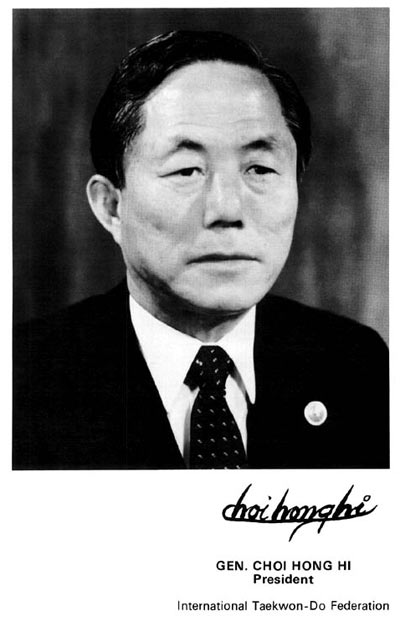
What is TKD?

Taekwondo is one of the most systematic and scientific Korean traditional martial arts, that teaches more than physical fighting skills. It is a discipline that shows ways of enhancing our spirit and life through training our body and mind. Today, it has become a global sport that has gained an international reputation, and stands among the official games in the Olympics.
What "TAE" "KWON" "DO" Mean?
Let's take a closer look at the meaning of the word "Tae" "Kwon" "Do." It is composed of three parts as shown in the English spelling, though it is one word in Korean.
Brief Introduction of the History of TKD

Taekwondo has been developing with the 5000-year long history of Korea, being called by several different names in the course. In Korea, Taekwondo began as a defense martial art called "Subak" or "Taekkyon," and developed as a way of training body and mind in the ancient kingdom of Koguryo, under the name of "Sunbae." In the Shilla period, it had become the backbone of Hwarangdo that aimed at producing leaders of the country.
TKD v.s. KARATE? Confusing?

Indeed,Taekwondo today is similar to the martial arts in other Oriental countries and shares some features with them, because in the course of its evolution it has gained many different styles that existed in the martial arts of the countries surrounding Korea, like Japan and China.
But Taekwondo is very different from many such oriental martial arts. First, physically it is very dynamic with active movements that include a mirage of foot skills. Second, the principle physical movements are in simpatico with that of the mind and life as a whole. Third, it possesses dynamic poses from another perspective.
What is the character of TKD?

Taekwondo can be characterized by unity: the unity of body, mind, and life, and the unity of the pose ["poomsae"] and confrontation, and cracking down. When you do Taekwondo, you should make your mind peaceful and synchronize your mind with your movements, and extend this harmony to your life and society. This is how in Taekwondo the principle of physical movements, the principle of mind training, and the principle of life become one and the same. On the other hand, the right poomsae lead to the right confrontation, which will eventually produce great destructive power.
How come we reach such a unity in Taekwondo? Taekwondo is a way of life, much like having a job, raising a family, fighting for a cause, or any one of numerous raison d'etre. What makes Taekwondo different from these is that it is an activity for survival in extremely antagonistic situations. One must always overcome the enemy that is trying to cause harm. But simply winning a fight is not enough to guarantee one's safety, because the enemy may recuperate and attack again. Moreover, there may be many other enemies than the one that was just defeated. One cannot ever feel safe unless one gains permanent peace. To attain this permanent or lasting peace, one needs unity. This is what Taekwondo aim for. Otherwise Taekwondo would be no different from any other street-fighting skill.
What is the philosophy of TKD?

Taekwondo contains thoughts that Han [Korean] people had developed through history. Its philosophy is easily explained with Hongik-Ingan, Jaese-Ihwa, or Hwarangdo spirit. Hongik-Ingan and Jaese-Ihwa were not only ideologies of Tangun Chosun's foundation, but also a fundamental thought of Han people. With time, these ideas developed into the Hwarangdo spirit and the Taekwondo philosophy today. Now, let's look at the principles contents of the philosophy.
"Hongik-Ingan" means universal welfare of mankind. It was the idea of the national foundation by Tangun, and the Taekwondo spirit too has inherited the idea of Hongik-Ingan. It is easily confirmed from the fact that the word of Taekwondo, itself means to suppress fighting and induce peace. On one hand, "Jaese-Ihwa" means that the world is educated in accordance with the reason of heaven. Taekwondo is a principle, not a simple connection with movements. It is the Korean traditional martial art characterized by the trinity of body, mind and life. Thus, the principle is the reason of all creation, and so it refers to the reason of heaven in Jaese-Ihwa. Therefore, human beings can be educated in accordance with the reason of heaven through correct training of Taekwondo. That's the very meaning of Jaese-Ihwa. Hongik-Ingan and Jaese-Ihwa appear clearly in the myth of the Korean foundation. According to it, "In the early age, Hwan-Wung, the son of Heaven established a nation called Baedal [earliest name of Korea]. He then announced the purpose of the national foundation as Jaese-Ihwa [educate with the reason of heaven] and Hongik-Ingan [universal welfare of mankind].
MY PURSUIT OF TKD
 2008.3.16
2008.3.16
Took part in the Youth TKD Competition of Sichuan Province
2008.2
Registered as a TKD athelet in Sichuan Province
2007.12
Graded to red belt, Level 2
2007.6
Graded to blue belt, Level 4
2006.12
Founded the TKD student club in UESTC. Deputy of the club.
2006.9
Registered In Zhengyi Dobu in Chengdu
2006.7
Graded to green belt, Level 6
2006.3
Graded to yellow-green belt, Level 7
2005.10
Join the TKD club in Chengdu College of UESTC
2005.8
Graded to yellow belt, Level 8
2005.8
Registered as a member of the TKD Association of Sichuan Province
2005.6.9
Registered in China-Korea TKD Dobu in Deyang City.My TKD life started
Want to share with me your feeling of TKD?